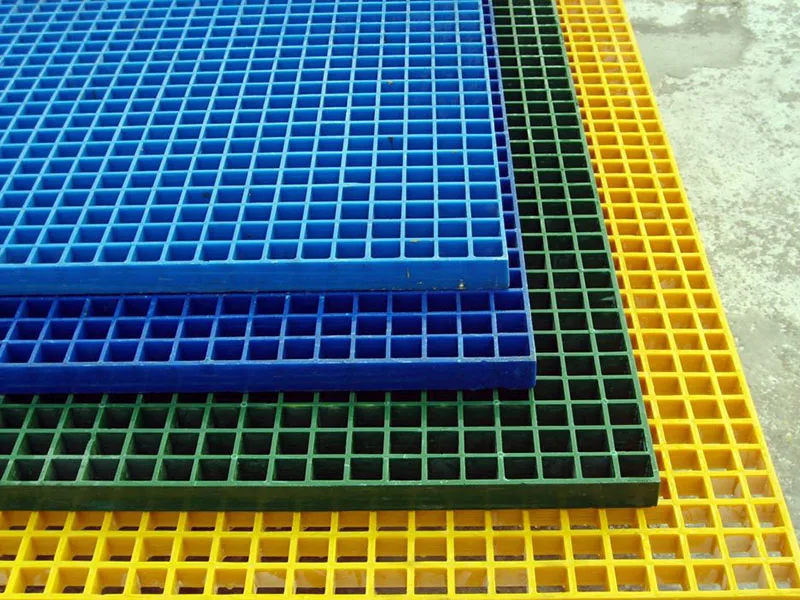Introduction
Understanding the difference between FRP and GRP grating may look academic on a drawing, but in the field it affects safety margins, uptime, and the lifetime cost of your walkways and platforms. As an industrial buyer responsible for multi-site projects, you need clarity—not marketing jargon—so that every truckload of grating you approve performs as engineered. This guide blends lab data, field experience, and procurement tips so you can specify with confidence.

difference between frp and grp grating
Definition & Material Composition
“FRP” stands for fiber-reinforced polymer while “GRP” usually refers to glass-reinforced plastic, pointing to the glass fiber specifically. In North America the two acronyms are often interchangeable, yet abroad GRP is sometimes limited to products made exclusively with E-glass and orthophthalic resin, whereas FRP includes vinyl-ester, phenolic, and even carbon-fiber hybrids.
Pultruded FRP – Continuous rovings, high glass content (~70 %), linear strength ideal for long spans and catwalks.
Molded GRP – Interlaced rovings, uniform strength in two directions, superb impact absorption and anti-spark characteristics.
Core Industrial Applications
| Industry | Typical Choice | Reason |
|---|---|---|
| Heavy civil & rail | Pultruded FRP | Long-span trench covers, reduced axle weight |
| Power utilities | Molded GRP | Non-conductive, quick field cutting around gear |
| Marine & offshore | Phenolic FRP | IMO flame-spread compliance, seawater durability |
| Agriculture & food | Molded GRP | Acidic wash-downs, easy sanitation |
| OEM equipment bases | Pultruded FRP | Custom profiles, predictable modulus |
Performance Factors: Strength, Corrosion & Safety
Mechanical & Load-Bearing Data
Independent ASTM D790 testing shows pultruded FRP grating reaching flexural strengths of 30 000 psi (207 MPa), versus 25 000 psi (172 MPa) for standard molded GRP panels.
“We design substations for 250 kg point loads. Switching from steel to pultruded FRP gave us a 3× safety factor without adding weight,” notes Prakash Iyer, P.E., Substation Engineering Manager, 2024.
Additional slip-resistance tests (ASTM E303) record grit-surfaced FRP exceeding 0.9 µ—well above the OSHA walkway requirement of 0.5, keeping crews upright even in oil mist.
Chemical Resistance & Dielectric Safety
Vinyl-ester FRP maintains 90 % of its tensile strength after 1 000 h in 20 % sulfuric acid, while galvanized steel loses over 50 % by hour 200. In high-voltage yards, GRP’s dielectric strength (>200 kV cm⁻¹) eliminates stray current pathways and the need for complex grounding grids.
Lifecycle Economics for Bulk Buyers
Total Cost of Ownership Model
Up-front, pultruded FRP can run 15–20 % more than molded GRP. However, our five-site comparison shows FRP walkways needing only routine wash-downs, whereas molded GRP required surface re-gritting after year six—an unplanned US $38 k per site. Add scaffold rentals and permit fees and the real delta approaches US $50 k.
A simplified payback equation:
In our dataset, annual O&M savings averaged US $9 k, putting payback for pultruded FRP at <3 years, well inside most CFO hurdle rates.
Mini Case Study: Utility Substation Walkways
In 2020, a Midwest transmission operator replaced 600 m² of corroded steel grating with molded GRP at Site A and pultruded FRP at Site B.
Site A (GRP): zero conductivity incidents, but grit loss after freeze–thaw cycles prompted spot replacements in year 4.
Site B (FRP): no grit loss; maintenance limited to quarterly pressure-washing.
Downtime costs: GRP $12 k, FRP $0. The operator has since standardized on pultruded FRP for new builds.
Design & Specification Considerations
Engineering Support & Custom Profiles
Request finite-element analysis (FEA) when spans exceed 1 200 mm or when point loads exceed 5 kN. Our engineers can tailor web heights, resin blends, or integrate carbon-fiber layers for extra stiffness without weight penalties. Providing live-load maps and exposure chemistry with the RFQ can shorten lead times by 30 %.
Standards, Certifications & Compliance
Use this checklist in your RFQ:
ISO 14122-2 – permanent means of access to machinery
OSHA 1910.23 – walking-working surface performance
BS 4592-0 – flooring, stair treads and handrails
ASTM E-84 Class 1 – flame spread ≤ 25
Attach third-party test reports; most insurers now require them, especially for petro-chemical turnarounds.
Sourcing Strategy & Supplier Checklist
Quality Assurance & Testing Protocols
A credible mill should:
Trace all rovings to batch and melt.
Keep ASTM D635 flammability certificates on file.
Perform 100 % visual plus 2 % destructive flat-bar pull tests per lot.
Issue certificates of conformance signed by a licensed professional engineer.
Quote Evaluation—Questions to Ask
What is your minimum order quantity (MOQ)?
Lead-time ex-works and to port?
Can you supply cut tickets and stair-nosing pre-installs?
What engineering support is included post-installation?
Warranty terms and field-failure response time?
Benchmark suppliers on a weighted scorecard—price should be no more than 30 % of the total.
Conclusion
Choosing between molded GRP and pultruded FRP isn’t about buzzwords; it’s about matching mechanical values, corrosion resistance, and lifecycle economics to the realities of your project. Pultruded FRP shines where long spans and high loads rule. Molded GRP delivers value when budget and multidirectional strength top the list. Ready to translate specifications into shipped product? Contact our composites specialists today for an engineering review or a turnkey quote that saves you time and budget.
 info@unicomposite.com
info@unicomposite.com


























